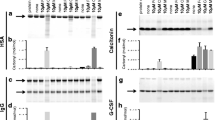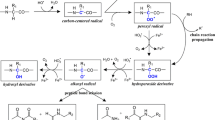ABSTRACT
Purpose
Therapeutic proteins are prone to oxidative modification during manufacturing, processing, and storage that may lead to degradation, aggregation, and immunogenicity. Protein carbonylation is an irreversible oxidative modification and has been identified as a hallmark of severe oxidative stress but not extensively studied for its impact on the stability and activity of therapeutic proteins.
Methods
We describe the application of a modified ELISA-based method to quantify global levels of carbonyl modification of complex proteins. We investigated protein oxidation of large protein molecules (transferrin, rabbit IgG, or β-glucosidase) and complex protein samples (human plasma) that were either stored in different buffer formulations, with varying amounts of divalent iron, or under different storage temperatures to determine the impact of different physicochemical stresses on carbonyl modifications.
Results
The modified ELISA allows for sensitive and specific carbonyl quantification with measurements that closely match those determined with the conventional spectrophotometric method. The method was useful for complex protein mixtures such as cell lysates without the need for additional procedures to remove DNA and RNA. Our findings demonstrate significant oxidative modification of each of the proteins stored in commonly used buffers and excipients at 37°C, 23°C, and 4°C. The carbonyl levels were further exacerbated with addition of trace amounts of Fe2+. We also measured the extent of protein aggregation under oxidizing conditions.
Conclusions
Collectively, our results indicate the importance of better characterizing carbonyl modification of proteins during their storage and use.





Similar content being viewed by others
REFERENCES
Walsh G, Jefferis R. Post-translational modifications in the context of therapeutic proteins. Nat Biotechnol. 2006;24(10):1241–52.
Mann M, Jensen ON. Proteomic analysis of post-translational modifications. Nat Biotechnol. 2003;21(3):255–61.
Dean RT, Fu S, Stocker R, Davies MJ. Biochemistry and pathology of radical-mediated protein oxidation. Biochem J. 1997;324(Pt 1):1–18.
Shacter E. Quantification and significance of protein oxidation in biological samples. Drug Metab Rev. 2000;32(3–4):307–26.
Cecarini V, Gee J, Fioretti E, Amici M, Angeletti M, Eleuteri AM, et al. Protein oxidation and cellular homeostasis: emphasis on metabolism. Biochim Biophys Acta. 2007;1773(2):93–104.
Torosantucci R, Schoneich C, Jiskoot W. Oxidation of therapeutic proteins and peptides: structural and biological consequences. Pharm Res. 2014;31(3):541–53.
Sola RJ, Griebenow K. Effects of glycosylation on the stability of protein pharmaceuticals. J Pharm Sci. 2009;98(4):1223–45.
Jenkins N, Murphy L, Tyther R. Post-translational modifications of recombinant proteins: significance for biopharmaceuticals. Mol Biotechnol. 2008;39(2):113–8.
Tovey MG, Legrand J, Lallemand C. Overcoming immunogenicity associated with the use of biopharmaceuticals. Expert Rev Clin Pharmacol. 2011;4(5):623–31.
Torosantucci R, Sharov VS, van Beers M, Brinks V, Schoneich C, Jiskoot W. Identification of oxidation sites and covalent cross-links in metal catalyzed oxidized interferon Beta-1a: potential implications for protein aggregation and immunogenicity. Mol Pharm. 2013;10(6):2311–22.
Purohit VS, Middaugh CR, Balasubramanian SV. Influence of aggregation on immunogenicity of recombinant human Factor VIII in hemophilia A mice. J Pharm Sci. 2006;95(2):358–71.
Kappos L, Clanet M, Sandberg-Wollheim M, Radue EW, Hartung HP, Hohlfeld R, et al. Neutralizing antibodies and efficacy of interferon beta-1a: a 4-year controlled study. Neurology. 2005;65(1):40–7.
Casadevall N, Nataf J, Viron B, Kolta A, Kiladjian J-J, Martin-Dupont P, et al. Pure red-cell aplasia and antierythropoietin antibodies in patients treated with recombinant erythropoietin. N Engl J Med. 2002;346(7):469–75.
Reipert BM, van Helden PMW, Schwarz H-P, Hausl C. Mechanisms of action of immune tolerance induction against factor VIII in patients with congenital haemophilia A and factor VIII inhibitors. Br J Haematol. 2007;136(1):12–25.
Berlett BS, Stadtman ER. Protein oxidation in aging, disease, and oxidative stress. J Biol Chem. 1997;272(33):20313–6.
Lu HS, Fausset PR, Narhi LO, Horan T, Shinagawa K, Shimamoto G, et al. Chemical modification and site-directed mutagenesis of methionine residues in recombinant human granulocyte colony-stimulating factor: effect on stability and biological activity. Arch Biochem Biophys. 1999;362(1):1–11.
Pan B, Abel J, Ricci MS, Brems DN, Wang DIC, Trout BL. Comparative oxidation studies of methionine residues reflect a structural effect on chemical kinetics in rhG-CSF. Biochemistry. 2006;45(51):15430–43.
Mulinacci F, Capelle MAH, Gurny R, Drake AF, Arvinte T. Stability of human growth hormone: influence of methionine oxidation on thermal folding. J Pharm Sci. 2011;100(2):451–63.
Yin J, Chu J-W, Ricci MS, Brems DN, Wang DIC, Trout BL. Effects of excipients on the hydrogen peroxide-induced oxidation of methionine residues in granulocyte colony-stimulating factor. Pharm Res. 2005;22(1):141–7.
Stadtman ER. Metal ion-catalyzed oxidation of proteins: biochemical mechanism and biological consequences. Free Radic Biol Med. 1990;9(4):315–25.
Xu G, Chance MR. Hydroxyl radical-mediated modification of proteins as probes for structural proteomics. Chem Rev. 2007;107(8):3514–43.
Aryal B, Jeong J, Rao VA. Doxorubicin-induced carbonylation and degradation of cardiac myosin binding protein C promote cardiotoxicity. Proc Natl Acad Sci U S A. 2014;111(5):2011–6.
Grimsrud PA, Xie H, Griffin TJ, Bernlohr DA. Oxidative stress and covalent modification of protein with bioactive aldehydes. J Biol Chem. 2008;283(32):21837–41.
Castro-Acosta RM, Rodriguez-Limas WA, Valderrama B, Ramirez OT, Palomares LA. Effect of metal catalyzed oxidation in recombinant viral protein assemblies. Microb Cell Factories. 2014;13(1):25.
Shao CH, Capek HL, Patel KP, Wang M, Tang K, DeSouza C, et al. Carbonylation contributes to SERCA2a activity loss and diastolic dysfunction in a rat model of type 1 diabetes. Diabetes. 2011;60(3):947–59.
Levine RL, Williams JA, Stadtman ER, Shacter E. Carbonyl assays for determination of oxidatively modified proteins. Methods Enzymol. 1994;233:346–57.
Reznick AZ, Packer L. Oxidative damage to proteins: spectrophotometric method for carbonyl assay. Methods Enzymol. 1994;233:357–63.
Kouno Y, Anraku M, Yamasaki K, Okayama Y, Iohara D, Ishima Y, et al. N-acetyl-l-methionine is a superior protectant of human serum albumin against photo-oxidation and reactive oxygen species compared to N-acetyl-l-tryptophan. Biochim Biophys Acta (BBA) Gen Subj. 2014;1840:2806–12.
Madian AG, Diaz-Maldonado N, Gao Q, Regnier FE. Oxidative stress induced carbonylation in human plasma. J Proteome. 2011;74(11):2395–416.
Dalle-Donne I, Rossi R, Giustarini D, Milzani A, Colombo R. Protein carbonyl groups as biomarkers of oxidative stress. Clin Chim Acta. 2003;329(1–2):23–38.
Shacter E, Williams JA, Lim M, Levine RL. Differential susceptibility of plasma proteins to oxidative modification: examination by western blot immunoassay. Free Radic Biol Med. 1994;17(5):429–37.
Buss H, Chan TP, Sluis KB, Domigan NM, Winterbourn CC. Protein carbonyl measurement by a sensitive ELISA method. Free Radic Biol Med. 1997;23(3):361–6.
Winterbourn CC, Buss IH. Protein carbonyl measurement by enzyme-linked immunosorbent assay. Methods Enzymol. 1999;300:106–11.
Levine RL, Garland D, Oliver CN, Amici A, Climent I, Lenz AG, et al. Determination of carbonyl content in oxidatively modified proteins. Methods Enzymol. 1990;186:464–78.
Luo S, Wehr NB. Protein carbonylation: avoiding pitfalls in the 2,4-dinitrophenylhydrazine assay. Redox Rep. 2009;14(4):159–66.
Zhou S, Schoneich C, Singh SK. Biologics formulation factors affecting metal leachables from stainless steel. AAPS PharmSciTech. 2011;12(1):411–21.
Ha E, Wang W, Wang YJ. Peroxide formation in polysorbate 80 and protein stability. J Pharm Sci. 2002;91(10):2252–64.
Zhao F, Ghezzo-Schoneich E, Aced GI, Hong J, Milby T, Schoneich C. Metal-catalyzed oxidation of histidine in human growth hormone. Mechanism, isotope effects, and inhibition by a mild denaturing alcohol. J Biol Chem. 1997;272(14):9019–29.
Hovorka SW, Hong J, Cleland JL, Schoneich C. Metal-catalyzed oxidation of human growth hormone: modulation by solvent-induced changes of protein conformation. J Pharm Sci. 2001;90(1):58–69.
Jorgensen L, Hostrup S, Moeller EH, Grohganz H. Recent trends in stabilising peptides and proteins in pharmaceutical formulation—considerations in the choice of excipients. Expert Opin Drug Deliv. 2009;6(11):1219–30.
Shen D, Coleman J, Chan E, Nicholson TP, Dai L, Sheppard PW, et al. Novel cell- and tissue-based assays for detecting misfolded and aggregated protein accumulation within aggresomes and inclusion bodies. Cell Biochem Biophys. 2011;60(3):173–85.
Lam XM, Lai WG, Chan EK, Ling V, Hsu CC. Site-specific tryptophan oxidation induced by autocatalytic reaction of polysorbate 20 in protein formulation. Pharm Res. 2011;28(10):2543–55.
Lam XM, Yang JY, Cleland JL. Antioxidants for prevention of methionine oxidation in recombinant monoclonal antibody HER2. J Pharm Sci. 1997;86(11):1250–5.
ACKNOWLEDGMENTS AND DISCLOSURES
This research was supported by the CDER Critical Path Initiative. We thank Dr. Joseph Kotarek (FDA) for help in analyzing protein aggregates. We would like to thank Elliot Rosen (FDA), Dr. Shen Luo (FDA), Dr. Nancy B. Wehr (NIH/NHLBI) and Dr. Rodney L. Levine (NIH/NHLBI) for critical reading of the manuscript or suggestions. The authors have no competing financial interests to disclose. The views expressed in this article are those of the authors and do not necessarily reflect the official policy or position of the U.S. Food and Drug Administration and the Department of Health and Human Services, nor does mention of trade names, commercial products, or organizations imply endorsement by the U.S. Government.
Author information
Authors and Affiliations
Corresponding author
Electronic supplementary material
Below is the link to the electronic supplementary material.
Supplementary Figure S1
Validation of DNPH removal step for carbonyl content determination. Following DNP derivatization, free unbound DNPH was removed either by ethanol/ethyl acetate extraction as described in Materials and Methods section (sample 1) or by size exclusion chromatography (sample 2). The Y axis indicates relative carbonyl content (%) in samples 2 compared to samples 1 for each protein preparation. These data were average of three separate experiments. Size exclusion chromatography utilizing Bio-Gel P-6 (Micro BioSpin chromatography columns, Bio-Rad Laboratories, Harcules, CA) : 100 μl of oxidized protein samples were derivatized with DNPH, precipitated with final 20% TCA, briefly rinsed with ethanol/ethyl acetate (1:1 v/v) and air dried. The precipitate was resolved in 70 μl of 6M Gu-HCl solution and the proteins were separated from free un-reacted DNPH by size exclusion column chromatography utilizing Bio-Gel P-6 spin column. (GIF 66 kb)
Supplementary Figure S2
Analysis of aggregate formation in rabbit IgG (RIgG) or transferrin stored at various temperature with or without Fe 2+ /H 2 O 2 /ascorbic acid. A. Analysis by Zetasizer dynamic light scattering. Y-axis denotes derived count rate (Kcps: kilocounts per second). B. Binding of molecular rotor dye. 25μg of RIgG or transferrin was mixed with Proteostat dye and RFU (excitation 550nm/emission 600nm) was measured following manufacturer’s instruction. (GIF 51 kb)
Rights and permissions
About this article
Cite this article
Uehara, H., Rao, V.A. Metal-Mediated Protein Oxidation: Applications of a Modified ELISA-Based Carbonyl Detection Assay for Complex Proteins. Pharm Res 32, 691–701 (2015). https://doi.org/10.1007/s11095-014-1496-y
Received:
Accepted:
Published:
Issue Date:
DOI: https://doi.org/10.1007/s11095-014-1496-y




